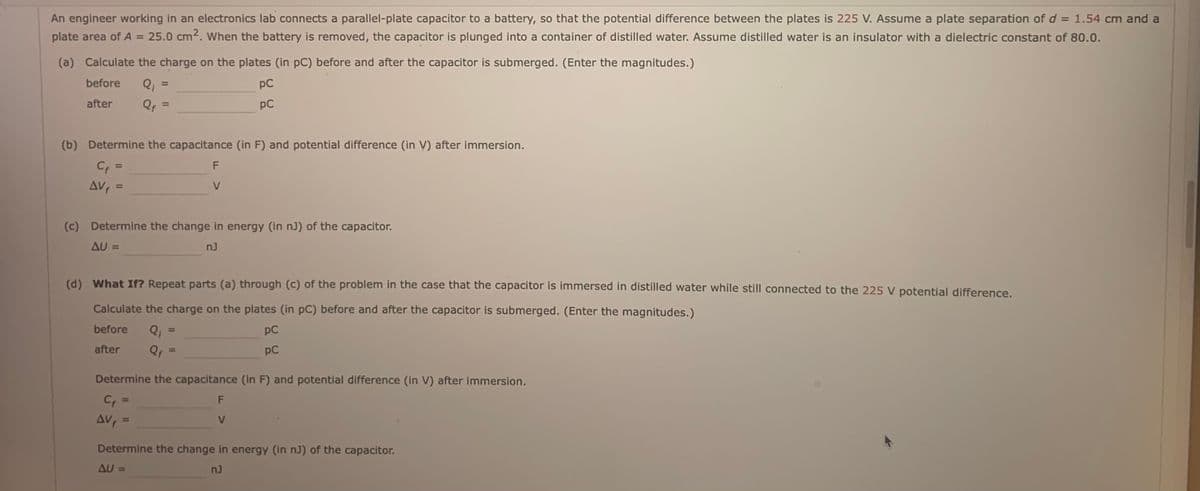An engineer working in an electronics lab connects a parallel-plate capacitor to a battery, so that the potential difference between the plates is 225 V. Assume a plate separation of d = 1.54 cm and a plate area of A = 25.0 cm?. When the battery is removed, the capacitor is plunged into a container of distilled water. Assume distilled water is an insulator with a dielectric constant of 80.0. (a) Calculate the charge on the plates (in pC) before and after the capacitor is submerged. (Enter the magnitudes.) before pC after Q, = pC (b) Determine the capacitance (in F) and potential difference (in V) after immersion. C, = AV, = (c) Determine the change in energy (in nJ) of the capacitor. AU = n)
An engineer working in an electronics lab connects a parallel-plate capacitor to a battery, so that the potential difference between the plates is 225 V. Assume a plate separation of d = 1.54 cm and a plate area of A = 25.0 cm?. When the battery is removed, the capacitor is plunged into a container of distilled water. Assume distilled water is an insulator with a dielectric constant of 80.0. (a) Calculate the charge on the plates (in pC) before and after the capacitor is submerged. (Enter the magnitudes.) before pC after Q, = pC (b) Determine the capacitance (in F) and potential difference (in V) after immersion. C, = AV, = (c) Determine the change in energy (in nJ) of the capacitor. AU = n)
Physics for Scientists and Engineers, Technology Update (No access codes included)
9th Edition
ISBN:9781305116399
Author:Raymond A. Serway, John W. Jewett
Publisher:Raymond A. Serway, John W. Jewett
Chapter26: Capacitance And Dielectrics
Section: Chapter Questions
Problem 26.12OQ: (i) Rank the following five capacitors from greatest to smallest capacitance, noting any cases of...
Related questions
Concept explainers
Dielectric Constant Of Water
Water constitutes about 70% of earth. Some important distinguishing properties of water are high molar concentration, small dissociation constant and high dielectric constant.
Electrostatic Potential and Capacitance
An electrostatic force is a force caused by stationary electric charges /fields. The electrostatic force is caused by the transfer of electrons in conducting materials. Coulomb’s law determines the amount of force between two stationary, charged particles. The electric force is the force which acts between two stationary charges. It is also called Coulomb force.
Question

Transcribed Image Text:An engineer working in an electronics lab connects a parallel-plate capacitor to a battery, so that the potential difference between the plates is 225 V. Assume a plate separation of d = 1.54 cm and a
plate area of A = 25.0 cm2. When the battery is removed, the capacitor is plunged into a container of distilled water. Assume distilled water is an insulator with a dielectric constant of 80.0.
%3D
(a) Calculate the charge on the plates (in pC) before and after the capacitor is submerged. (Enter the magnitudes.)
before
pC
%3D
after
pC
%3D
(b) Determine the capacitance (in F) and potential difference (in V) after immersion.
F
%3D
AVF
V.
%3D
(c) Determine the change in energy (in nJ) of the capacitor.
AU =
nJ
(d) What If? Repeat parts (a) through (c) of the problem in the case that the capacitor is immersed in distilled water while still connected to the 225 V potential difference.
Calculate the charge on the plates (in pC) before and after the capacitor is submerged. (Enter the magnitudes.)
before
Q, =
pC
after
Qr
pC
Determine the capacitance (in F) and potential difference (in V) after immersion.
AV
%3D
Determine the change in energy (in nJ) of the capacitor.
AU =
nJ
Expert Solution
This question has been solved!
Explore an expertly crafted, step-by-step solution for a thorough understanding of key concepts.
This is a popular solution!
Trending now
This is a popular solution!
Step by step
Solved in 3 steps with 2 images

Knowledge Booster
Learn more about
Need a deep-dive on the concept behind this application? Look no further. Learn more about this topic, physics and related others by exploring similar questions and additional content below.Recommended textbooks for you

Physics for Scientists and Engineers, Technology …
Physics
ISBN:
9781305116399
Author:
Raymond A. Serway, John W. Jewett
Publisher:
Cengage Learning

Principles of Physics: A Calculus-Based Text
Physics
ISBN:
9781133104261
Author:
Raymond A. Serway, John W. Jewett
Publisher:
Cengage Learning

College Physics
Physics
ISBN:
9781305952300
Author:
Raymond A. Serway, Chris Vuille
Publisher:
Cengage Learning

Physics for Scientists and Engineers, Technology …
Physics
ISBN:
9781305116399
Author:
Raymond A. Serway, John W. Jewett
Publisher:
Cengage Learning

Principles of Physics: A Calculus-Based Text
Physics
ISBN:
9781133104261
Author:
Raymond A. Serway, John W. Jewett
Publisher:
Cengage Learning

College Physics
Physics
ISBN:
9781305952300
Author:
Raymond A. Serway, Chris Vuille
Publisher:
Cengage Learning

College Physics
Physics
ISBN:
9781285737027
Author:
Raymond A. Serway, Chris Vuille
Publisher:
Cengage Learning

Physics for Scientists and Engineers: Foundations…
Physics
ISBN:
9781133939146
Author:
Katz, Debora M.
Publisher:
Cengage Learning
